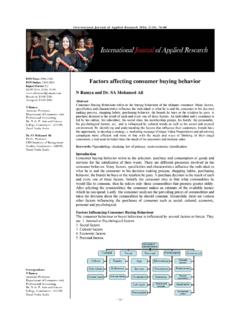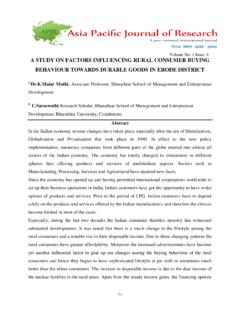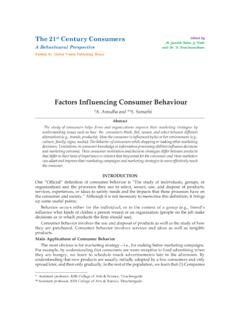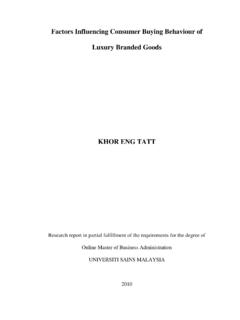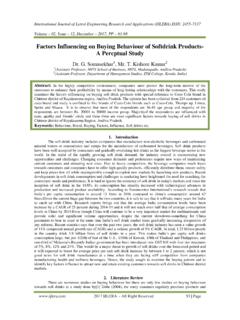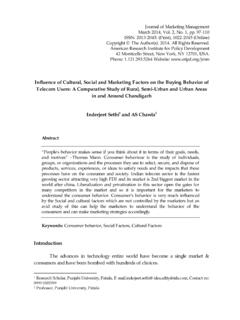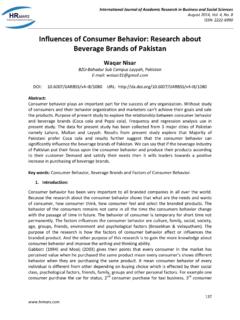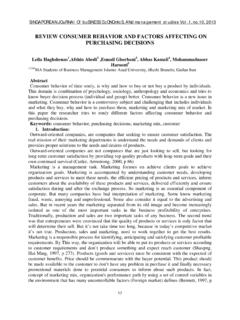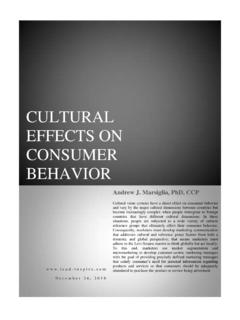Transcription of Factors influencing Consumer Perception (CP) towards TV ...
1 The Journal of Pacific Studies, Volume 34 Issue 2, 201463 Factors influencing Consumer Perception (CP) towards TV and Newspaper Advertising Rejieli Liligeto, Gurmeet Singh and Rafia NazABSTRACTThis study identifies three Factors namely: advertising media; economic and social Factors and personal characteristics; that impact customer Perception (CP) towards TV and newspaper advertising. While the extent of impact tends to vary, it is not possible to single out the to say, of all the Factors identified to have influenced Fiji consumers Perception towards TV and newspaper advertising, only education of consumers stands out as a predominant : Consumer Perception ; TV; Newspaper; Advertising media, Fiji64 The Journal of Pacific Studies, Volume 34 Issue 2, 20141.
2 INTRODUCTIONThe concept of advertising has been subject to diverse interpretations. Advertising could be explained as the mechanism through which people are introduced to new things that they do not know about (Coulter et al., 2001) and helps consumers interpret experiences (La Tour et al., 2004). It is also known as a creative art of communication (Koslow et al., 2006) and serves as a promotional activity in creating a strong institutional brand image in the minds of the public (Scott & Walker, 2010). Consumer Perception , on the other hand, is described as acting and reacting on what one sees (Kotler et al. 1998, p.)
3 187). In putting the two concepts together, it can be said here that - advertising is the driving force (Akaka & Alden, 2010), responsible for shaping consumers perceptions and inducing a behavioural response (Jones et al., 2010). Advertising is an undeniable force adept in reaching consumers across the globe and advertising messages needed to be projected through identified mediums/ media to consumers. Reid and King (2003) describe the advertising medium as the vehicle of deliverance. Two such vehicles that continue to maintain their prominence over the years till today and that are widely used by advertisers to promote their products are TV and newspaper (Thompson, 2007).
4 A quick glance at the Fiji advertising and media environment reveals that since the mid 1970 s, deregulation of the Fiji media industry gave rise to several daily newspapers and publications, and radio and TV commercials, and digital media in the 1990 s (Bhagwan-Rolls, 2007), which Fiji businesses today have, favourably employed as advertising tools to reach consumers (Liu, 2002). Regrettably, the advertising environment in Fiji was reported in the Pacific Media Center- Nius beat by The Consumer Council of Fiji as unsatisfactory with advertisement producers exploiting a grey area in current codes of practice (Foster, 2008). The deficiency presented in Fiji s advertising industry reflects immaturity of Fiji s advertising market and this does not help when consumers have the subsequent view that - media is the message (Dahle n, 2005); in that whatever the ad says or what the advertiser intends to convey is also what it should mean to consumers (Zhou & Belk, 2004).
5 Such practices and ideologies are ineffective in Fiji s advertising environment. The purpose for this research is suggested by a gap in the advertising literature driven by the fact that all documented literature on Consumer Perception was directed internationally. Since there has been no focus on Fiji as a nation, it is therefore more necessary to explore the Perception of consumers towards TV and Newspaper advertising in particular. This study is intended to contribute to the literature methodologically, theoretically, and managerially. Although many researchers have come up with different models of variables that they believe influence Consumer Perception of advertising and is critical to a successful Consumer reaction, this may not be relevant to Fiji s situation and condition.
6 Given the context, this leads to the third intention of the study, and that is to develop a model that reflects Fiji Consumer s Perception towards TV and newspaper advertising, which can be used by marketers and corporate communicators in Fiji to position their ads in the TV and newspaper more effectively and generate a more positive response from consumers. The Journal of Pacific Studies, Volume 34 Issue 2, 201465 The presentation of the paper is as follows: Section 2 presents a review of the relevant literature and identifies the theoretical framework and development of the hypothesis pertaining to Consumer Perception of advertising.
7 Section 3 looks at the empirical designs and the methodology used in the study. Section 4 displays the demographic profile, hypotheses test results and interpretation followed by a detailed discussion and analysis. Section 5 discusses the implications, states the limitation of the research, provides recommendations and suggestions for future LITERATURE REVIEW & HYPOTHESES DEVELOPMENTIn a number of empirical studies involved with advertising, two theories that commonly come up in association with CP are the cognitive theory and the affective theory (Park & McClung, 1985; Park & Young, 1986; Gyo-Lee & Thorson, 2009). Cognitive involvement refers to the thought-related reactions generated by stimuli (Blackwell, Miniard & Engel, 2001) while affective involvement consists of feelings and arousal induced by stimuli (Dub , Cervellon, & Jingyuan 2003; Yoo & MacInnis, 2005).
8 Ahuvia (2005), suggested that an individual s relationship with any (consumption) object may involve positive feelings of affect, as well as identification. These theories collectively demonstrate that when consumers are exposed to advertising in this case TV and newspaper, they cognitively conceptualise or think about what they see, and if they are affectionate about it because they identify themselves with the ad, the probability for a positive reaction is high. Reversibly, negative cognition or Perception of the ad will cause disinterest and negative self-identity and so the chances of a negative Consumer reaction towards the ad are high.
9 Tylee (1989) and Meenaghan (2001) explain that this is similar to a see-saw Perception towards literature on advertising may have identified many variables that may influence the overall Perception of consumers towards advertising, it is not practically and methodologically sound to include all in this model. Hence, only the variables perceived in this research to influence Fiji consumers Perception towards TV and newspaper advertising, and literature pertaining to the components of the conceptualised model will be examined, whereas the operationalisation of testing the variables in this model will be presented in Section 4.
10 The Factors affecting Consumer Perception towards advertising are examined under three main pillars: Perceived type of advertising medium. Personal, economic and socio-cultural Factors . Perceived product information and attributes. PERCEIVED TYPE OF ADVERTISING MEDIUMIt is factual knowledge that for advertising to reach the Consumer , a medium is needed to present market information. However, the decision as to which media to watch or read the information is purely the Consumer s choice as Mya (2006) metaphorically places it - media selection will be 66 The Journal of Pacific Studies, Volume 34 Issue 2, 2014driven by where consumers eyeballs are going.
